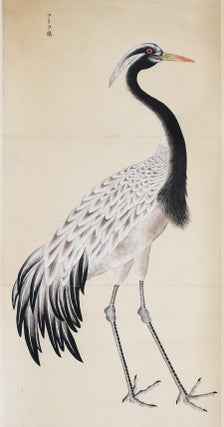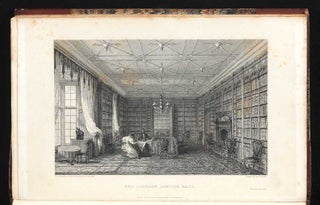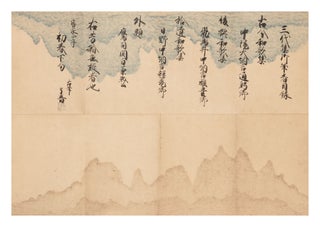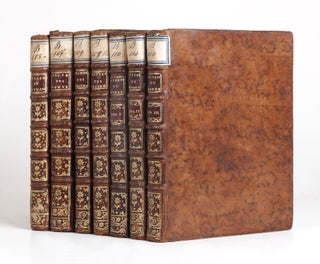The Essential Japanese Dictionary
Setsuyoshu 節用集 [Convenient & Useful Dictionary, a Vade Mecum by Manjuya Hayashi Soji]. Edited by Manjuya Hayashi Soji.
Eight vertical lines of text per page. 98 folding leaves. Oblong 8vo (144 x 206 mm.), orig. (or very early) dark thick wrappers, new stitching. [Nara?: Manjuya Hayashi Soji, ca. 1532-73].
One of the earliest surviving setsuyoshu, the essential Japanese dictionary, “one of the mainstays of the publishing industry and…probably the most likely book to be found in a house of few books.”–Kornicki, The Book in Japan, p. 248. Widely used from the 15th century through the early Meiji period; there were more than 500 editions in many styles, additions, and formats. All early editions are extremely rare, as they were used to death.
Anonymously compiled sometime in the second half of the 15th century, setsuyoshu was originally a dictionary used for looking up Chinese characters using the Japanese reading of that character or word. Through the 16th century, it remained a Japanese language dictionary of characters appropriate to the vocabulary popular in Muromachi times, with occasional word commentary and etymological explanation.
The earliest setsuyoshu (kohon setsuyoshu or “old-style” setsuyoshu), are divided into three main categories, based on the first word listed in the dictionary: the earliest, Ise (the old name for Mie prefecture), and two offshoots: Indo (India) and inui (northwest). Our edition is an example of the earliest, the Ise bon. The first printings were in the late 15th century, and all of are of the greatest rarity; we find no 15th- or 16th-century edition of the setsuyoshu in WorldCat.
This is the first printing of Manjuya Hayashi Soji’s edition of the setsuyoshu. It is printed on rather thick paper in kanji and katakana, imitating the square style of handwriting (kaisho), used for scholarly and formal works. The National Diet Library owns a copy of our edition and dates it as “late Muromachi” (that era ended in 1573). The copies at Tenri, Waseda, and Toyo Bunko are quite incomplete; our copy is absolutely complete. There is also a 1596 printing.
The audience for the kohon setsuyoshu was the literate elite, and they used the dictionary mainly for artistic pursuits. By the late 17th century, the setsuyoshu developed from its initial dictionary form into a household encyclopedia with additional text containing useful knowledge for daily life.
The editor and publisher of our edition was Soji Hayashi (1498-1581), book collector, scholar of poetry, and a 7th-generation member of a family famous for operating a bean-jam steamed bun shop (manjuya) in Nara (the company still exists). The name of the shop was so famous — its buns were favored by a number of legendary warriors and shoguns — it became attached to this edition.
The main section of the dictionary continues until leaf 90, where addenda begin, one listing the wards of Kyoto (three pages), and another of additional words. The organization of the dictionary is by iroha order and further divided by eleven categories or mon: heaven and earth, ethics, natural history, food, numbers, and others. Each word has a pronunciation guide in katakana.
This copy was offered by Shigeo Sorimachi in 1982 in his monumental Kobunso aisho zuroku catalogue for 5,000,000 yen. Sorimachi has placed his seal on the final leaf of text.
Our copy is in very good condition, with clear dark printing. The first leaf is rather soiled, and there is some light soiling throughout and some dampstaining at end. There are two wormholes in the beginning leaves are not offensive. Seven leaves towards the end have some minor worming. There is also some minor marginal worming. Preserved in a chitsu.
❧ Don Clifford Bailey, “Early Japanese Lexicography” in Monumenta Nipponica, Vol. 16, Nos. 1/2 (1960), pp. 1-52. Steffen Remvik, Setsuyoshu in Early Modern Japan: A Book Historical Approach, PhD dissertation, January 2017 (online).
Price: $85,000.00
Item ID: 6657

![Item ID: 6657 Setsuyoshu 節用集 [Convenient & Useful Dictionary, a Vade Mecum by Manjuya Hayashi Soji]. Edited by Manjuya Hayashi Soji. MANJUYA BON.](https://jonathanahill.cdn.bibliopolis.com/pictures/6657.jpg?width=768&height=1000&fit=bounds&auto=webp&v=1559334396)
![Setsuyoshu 節用集 [Convenient & Useful Dictionary, a Vade Mecum by Manjuya Hayashi Soji]. Edited by Manjuya Hayashi Soji.](https://jonathanahill.cdn.bibliopolis.com/pictures/6657_2.jpg?width=320&height=427&fit=bounds&auto=webp&v=1559334396)



